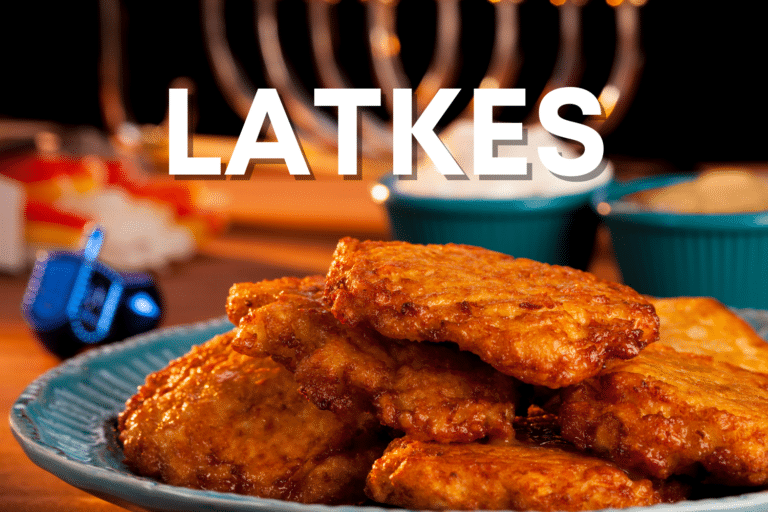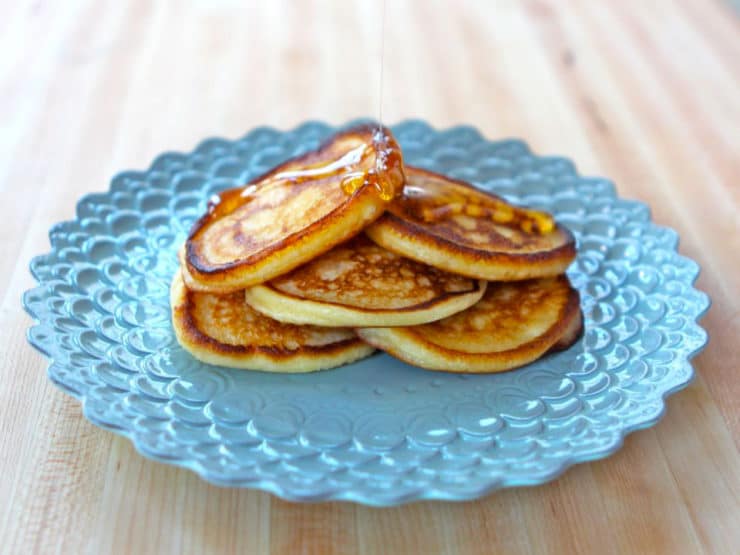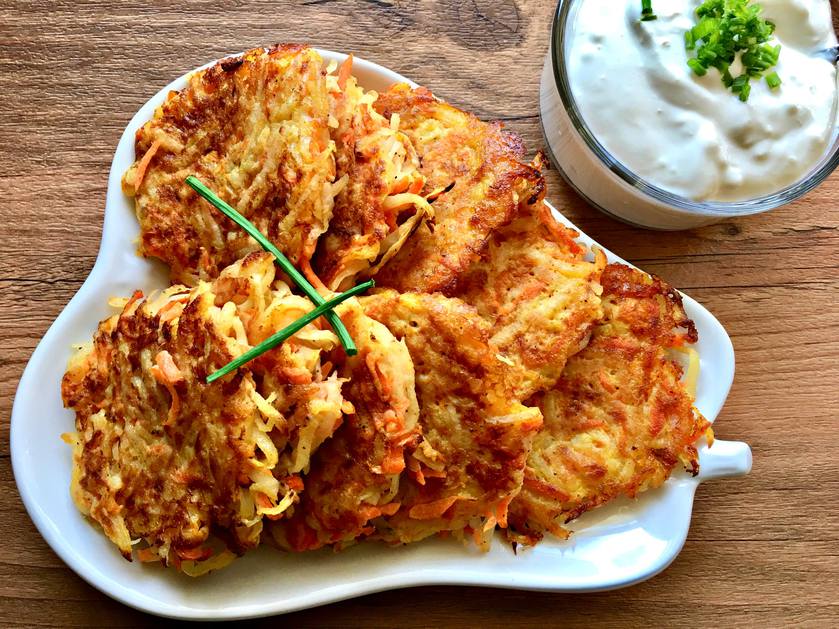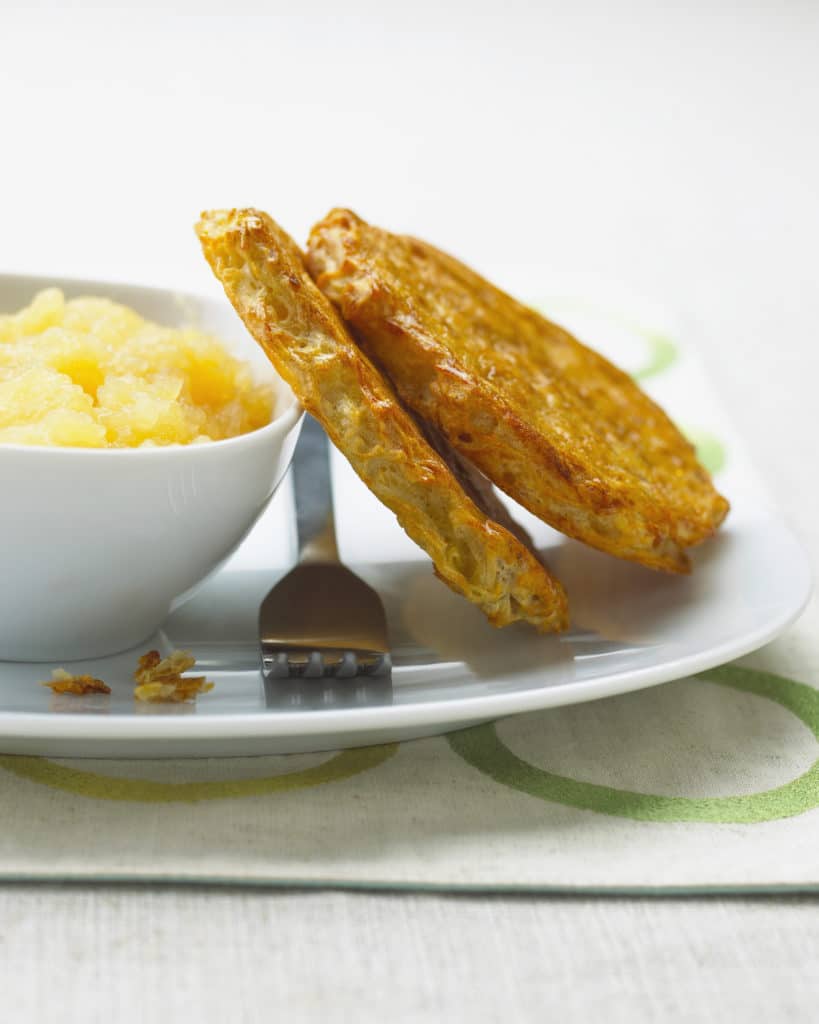
If there’s one food that you probably associate with Hanukkah — it’s latkes! These delicious, fried potato pancakes are arguably the best part of the holiday.
While Jews have been documented eating forms of fried pancakes for Hanukkah since the 12th century, the potato latkes we know and love only came around in the 19th century.
Let’s peel back all the layers of the latke and take a deep (fried) dive into the history of everyone’s favorite Hanukkah delicacy.

What are latkes?
Latkes are fried potato pancakes that are often served with sour cream and apple sauce on Hanukkah.
The word “latke” was first coined in the 15th century and is derived from the Greek word “elaion” meaning olive oil and the Slavic “oladka” for a little fried pancake.
While traditionally, potato latkes reign supreme on Hanukkah, many people have swapped up the recipe to use anything from sweet potato to cauliflower pancakes to celebrate Hanukkah. Any vegetable that you can shred and make into a patty can be latke-fied!
The origins of latkes
While it may be shocking, latkes are a relatively recent addition to the lexicon of Jewish cooking. While it’s now a Hanukkah essential, Jews didn’t fry up potato latkes until the mid-1800s.

Before potato latkes, Jews traditionally ate cheese latkes to honor Judith, an often-forgotten hero of the Hanukkah story. Judith, who rabbinical scholars often cite as the keystone to the miracle of Hanukkah, seduces the Assyrian general Holofernes with wine and salty cheese (some scholars claim these were fried into cheese latkes). When the general is drunk and falls asleep Judith takes his sword and beheads him with it. As a result, the ancient Israelites defeated the Assyrians. Starting at least in the 1300s, Jews began to eat fried cheese to celebrate Judith.
The first popular cheese latke was reportedly ricotta pancakes, a Hanukkah tradition that originated in Italy and spread through Europe over time.
The evolution of latkes
Cheese pancakes made a lot of sense in places like Central and Southern Europe where olive oil and butter were easily accessible cooking fats.
For the Jews of Eastern Europe, however, these were much less common. Instead, animal fats were more accessible.

Since animal fats, like schmaltz, could not be eaten with dairy under kosher law, the Hanukkah cheese pancake transitioned into vegetable pancakes, utilizing the root vegetables that were a staple to the Ashkenazi diet.
The 1600s brought potatoes to Europe from the New World, but it took 200 years for them to become a staple. Initially, they were seen as food for livestock and then were integrated into the diet of prisoners. Since Potatoes are filled with nutrients, can grow in poor-quality soil, and can be stored well, Europeans added them into their diets.
After famines in 1839 and 1840 due to crop failure, potatoes took hold in Eastern Europe and were planted en masse. Soon potatoes became cheaper than wheat and flour, making the potato latke the choice for Jewish peasants in Europe.
Potato latkes became an important part of Hanukkah because it aligned with the December tradition of slaughtering geese. Starting in the early fall, the geese were fed immense quantities to fatten them up (this tactic was so effective Jews were known for the best foie gras in France).

To survive cold winters, goose down and feathers were used for warmth and goose meat was preserved in a slow-cooked confit to eat throughout the winter. This left Jews with a lot of extra goose fat to use. With potatoes being so cheap and goose fat so plentiful, potato lakes became the official Hanukkah delicacy.
When the waves of Jewish immigration began from Europe to the United States, Jewish immigrants brought along latkes, which soon became a deli staple because of their delicious taste and nutritional value.
